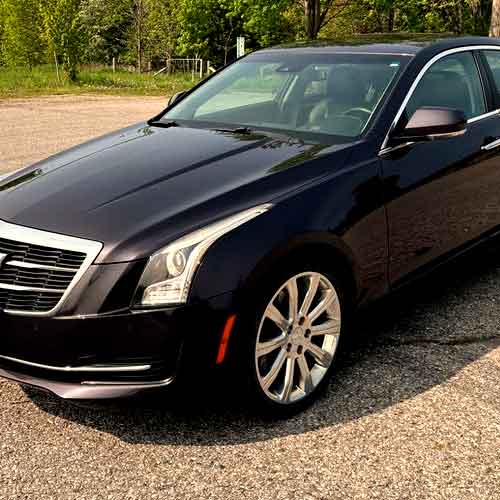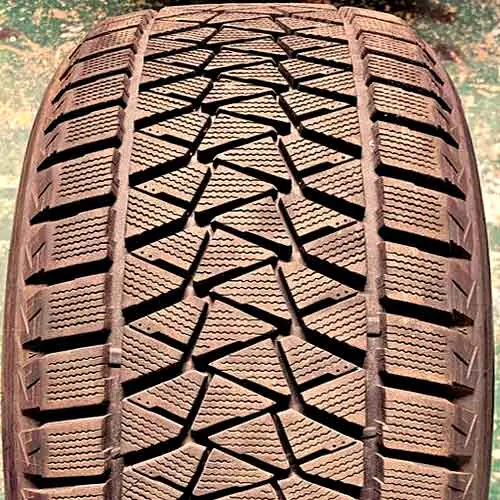The Bridgestone Blizzak DM-V2 stands as a testament to the Japanese brand’s commitment to winter road safety for Light Truck/SUV drivers. The tire promises an unmatched grip whether you’re driving through slush, fresh snow, or treacherous ice. Let’s see what more it has to offer.

The Bridgestone Blizzak DM-V2 offers great performance in a range of conditions, excelling particularly in wet traction, ice stability, and snow handling. However, it could benefit from enhancements in areas like noise reduction, dry steering responsiveness, and fuel efficiency due to its inherent design elements.
Info on Sizes: The Bridgestone Blizzak DM-V2 comes in 15 to 22 inches with following.
- Speed ratings: R, S and T.
- Load ratings: SL and XL.
- Tread depth: 13 or 14/32″.
- Weight: 27 to 45 lbs.
The DM V2 is the best option if you’re looking for a winter tire “for your SUV”.
In fact, its so great that I added it to my list of top winter tires (stud-less), check it here:
https://snowytires.com/best-studless-winter-tires/
Table of Contents
Tire’s Structure
The Bridgestone Blizzak DM-V2 comes with a biting symmetric tread pattern.

Though the tire is missing with a directional pattern, commonly seen on winter tires, it’s symmetric structure allows it to form 5 block columns.
Here the outer two ribs, features squared off shoulder blocks, forming prominent lateral grooves, and wide circumferential grooves (containing central lugs).
These shoulders are characterized by off-set edges, and a lot of wave-like siping.
The central lugs on the other hand, feature triangular shapes. Though they also have similar siping pattern along with off-set edges.
Moreover, they also form notches (in between two of each block pairs).
Also note how, these lugs form interconnected groove structure, which is really important for slush and water evacuation.
Wet Performance
Wet traction is dependent on the tire’s ability to clear water out of its tread.
And that provides you with wet traction and resistance to hydroplaning. Let’s check out both one by one.
Wet Grip
Wet grip, similar to dry grip, as here, you need rubber to properly grip the road, the more the better. But the thing is water comes in the way literally, as its not compressible.
So it has to go somewhere (out of tread), otherwise it would cause the tire to float and slip.
That’s why tires have sipes and grooves.
Grooves clear out at a major scale, throwing water out through grooves. I’ll talk about it more in hydroplaning section below.
Sipes on the other hand, come in later, as they suck up the remaining water particles in their slits.
Now the Bridgestone Blizzak DM-V2 offers pretty decent overall wet grip here, with it’s numerous biters.
Moreover, the tire’s new gen compound offers NanoPro Tech Multicell tread composition, as Bridgestone calls it. Simply put, this doesn’t allow water particles to stick on to the tread.
Moreover, the tire already clears off a lot of water through its grooves, allowing for decent resistance to hydroplaning. This helps here because more water is able to get out, and less is there for sipes, improving their efficacy to clear water further.
For Your Info: Out of all winter tires, I’ve reviewed, the Continental VikingContact 7 (review), offers one of the best overall wet performance.
Resistance to Hydroplaning
Hydroplaning is basically floating of a tire, when it’s not able to clear out water through grooves.
So how well grooves are structured are really important here.
That’s why most of the wet traction comes from aquaplaning resistance on Blizzak DM-V2.
Although the Bridgestone tire’s missing directional pattern should hinder it’s water evacuation process, the tire still offers one of the best results (relatively), thanks to its superior inter-connectivity of its grooves.
As discussed in its tread design section, the grooves on this tire run everywhere. prominently joining up with the outer circumferential grooves and lateral voids of shoulders (which are pretty efficient at expelling the water out).
Moreover, the tire also has the advantage of greater tread depth going up to 14/32″ (a lot more than its direct competitors). So this further allows for water clearing abilities.
Overall Winter Performance
When it comes to winter performance, there are two variables here, how well the tire is on snow, and on ice.
Let’s check out both.
Ice Traction
When it comes to ice traction, you need a lot of control and stability, as icy conditions are very slippery and offer very little natural friction.
That’s why you need a lot of gripping elements on the tire’s tread, along with a compound that can naturally stick well on ice.
Having said that, the Bridgestone Blizzak DM-V2 perform pretty great here, where it only lacks marginally from the best tire in its category.
For Your Info: If ice traction is your main concern, you should know that the Bridgestone Blizzak WS90 (review) is the top ranking winter tire here.
Snow Traction
Snow performance tells you about the dynamics of a tire on soft, salt-like (on-road) snow, and here, there are a few factors to note.
One, how well the tire is able to act as a shovel. This basically throws the ground backwards, generating acceleration.
Two, how well the tire is able to provide snow to snow contact, which is important, because this contact generates greater friction compared rubber to snow contact.
Now among its direct competitors, the Bridgestone Blizzak DM-V2 comes on top, offering fastest snow handling, braking and overall acceleration scores.
And it makes sense too, since the tire is equipped with a lot of in-groove notches, forming superior snow-to-snow contact, while it’s wider grooves and greater tread depth (on average) throw out excess snow particles efficiently.
For Your Info: Out of all it’s winter tires I reviewed, the Michelin X-Ice Snow (review) offers the best overall snow performance.
Tread Longevity
When it comes to tread longevity, you should know that it’s predominantly depends on tire’s tread compound used, depth, and overall weight.
Now the Bridgestone Blizzak DM-V2 offer above average performance here, only lacking slightly behind the Michelin Latitude X-Ice, the leading tire here (offering 40k miles warranty, whereas Bridgestone doesn’t come with any).
So why is it happening, even though the tire gives you up to 14/32″ of tread depth.
Well, this has to do with it’s greater weight, and rolling resistance. You see, sure, greater tread depth takes more time to reach down to 2/32″ (which is the legal limit in US).
But it also causes lugs to bend more too.
And they are already pretty susceptible to that with the tire’s heavier weight and ton of biting edges, negatively impacting the tire’s tread longevity.
Comfort Performance
Tire comfort is largely determined by how smooth the overall ride is (referring to its stability and efficacy to soak up road imperfections), and how quiet it is on different types of surfaces.
Both of these are judged by the tire’s inner and outer construction, where rubber composition, tread pattern and sidewall design play the most crucial roles.
Let’s discuss both these factors, i.e. tire’s noise and impact comfort performance (separately).
Tread Noise
Air is the main cause of most of the tread noise, where the air particles colliding with the tread create noise, which then echo, producing what’s known as in-groove resonance. And that leads to cavity noise and tread reverberations.
Now simply put, the more voided up the tire is, the noisier it’d be on different types of surfaces.
That’s why the Bridgestone Blizzak DM-V2 with such voided up structure lacks here. Though Sl sizes still do a lot better here compared to XL ones.
Bumps Absorption
Since tires are directly in contact with the bumps, they are first ones to handle them, besides the tire’s suspension system.
And how well the tire does here depends on two variables, its soaking abilities and stability.
Bridgestone Blizzak DM-V2 takes the lead here, mainly because of its ample tread depth. Simply put, the more the rubber, the better, (keeping stability in check).
Dry Performance
Overall dry performance is two parts grip and handling.
And here grip is further divided in to two, longitudinal and lateral grip. Let’s check all of them one by one.
Dry Longitudinal Grip
This ones is the tire’s straight line grip and depends on mainly on how well its tread (predominately form the middle) meets with the road.
Moreover, there are other factors involved here too, including tire’s weight and overall tread biters, and these define the overall tire’s braking performance (which directly measures this longitudinal grip).
Compared to it’s direct competitors, the tire only lacks by 2 feet in braking distance (on average), from the highest ranking tire here (Yokohama IceGuard iG51v).
Dry Handling
Overall dry handling depends on lateral grip. But that’s only half piece of the puzzle, where you get the whole picture when you define the tire’s steering feedback.
Now lateral grip depends on shoulders, as they make the most contact with the road (as weight concentrates on them, as the tire is turning).
And steering depends on flexing of the lugs.
Now ironically, although the Bridgestone Blizzak DM-V2 offers one of the best lateral traction values, it’s overall handling (as seen by it’s average lap times) is trailing pretty far behind, as it gives you a pretty lagging steering responsiveness.
So why is it happening?
Well this has to do with it’s greater relative weight and tread depth going up to 14/32″.
These basically cause its lugs to bend more, and bending of lugs take time to recover, adding to overall handling times.
Fuel Economy
Fuel efficiency in tires is directly related to their weight and traction, both of which influence rolling resistance.
And so it clearly makes sense why the Bridgestone Blizzak DM-V2 is one of the most lacking tire here in its category of winter tires.
Simply put, the tire is pretty bulky, one of the heaviest, and that combined with it’s softer compound and greater tread depth (almost 2/32″ greater on average, relatively), you get a lot of generated rolling resistance here.
And so overall fuel economy gets compromised with this tire.
Conclusion
So overall, the Bridgestone Blizzak DM-V2 tire exhibits pretty decent performance across varied conditions.
It excels in:
- Efficient water evacuation and hydroplaning resistance, especially in wet conditions.
- Notable ice traction, providing stability and control in slippery conditions.
- Superior snow performance, achieving faster handling, braking, and overall acceleration due to its effective in-groove notches and wider grooves.
While its performance can be improved in:
- Noise reduction, as it tends to produce more tread noise on various surfaces.
- Steering responsiveness in dry conditions, which is affected by its greater weight and tread depth.
- Fuel economy, as its bulkiness and tread depth lead to increased rolling resistance.